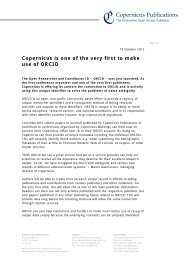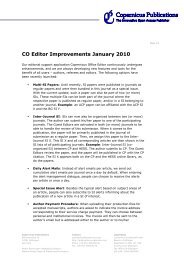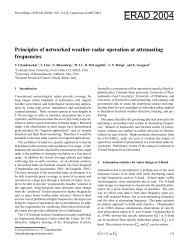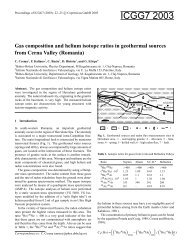Forecast period - Copernicus.org
Forecast period - Copernicus.org
Forecast period - Copernicus.org
You also want an ePaper? Increase the reach of your titles
YUMPU automatically turns print PDFs into web optimized ePapers that Google loves.
EMS/ECAM2011, Freie Universität, Berlin, 15 September 2011<br />
Studies at MRI toward cloud resolving ensemble NWP<br />
-Next generation supercomputer project and the Tokyo<br />
metropolitan area deep convection field campaign-<br />
K. Saito 1 ,<br />
H. Seko 1 , T. Kawabata 1 , Y. Shoji 1 , T. Kuroda 2,1 , T. Fujita 3 and O. Suzuki 1<br />
1 Meteorological Research Institute/JMA<br />
2 Japan Agency for Marine-Earth Science and Technology<br />
3 Numericak Prediction Division/JMA<br />
1. Background<br />
2. The K-computer<br />
3. Tokyo Metropolitan Area Convection Study (TOMACS)
2900 km<br />
MSM: operational mesoscale model at JMA<br />
3600 km<br />
1. Background<br />
• JMA nonhydrostatic model with<br />
5km L50, 3hourly<br />
• Initial condition:<br />
Nonhydrostatic 4DVAR<br />
(JNoVA)<br />
• Boundary condition: High<br />
resolution GSM (TL959L60)<br />
forecasts
Predictability of heavy rainfalls<br />
Heavy<br />
rains with<br />
orographic<br />
forcing<br />
Heavy rains<br />
with synoptic<br />
forcing<br />
‥relatively predictable in the current mesoscale NWP up to a point<br />
Convective rains<br />
without strong<br />
synoptic/orographic<br />
forcing<br />
‥difficult to predict due to<br />
• small spatial/temporal scales<br />
• sensitive to small perturbations in<br />
initial conditions
Example of orographic heavy rainfall<br />
Radar-AMeDAS Observed rainfall<br />
03-06 UTC, 19July 2011<br />
MSM prediction FT=21<br />
03-06 UTC, 19July 2011<br />
A strong typhoon (T201106 Ma-on) hit western Japan and record breaking 851mm<br />
rainfall was observed in one day (19 July 2001). MSM model accurately predicted<br />
the orographically forced rainfall.
Example of frontal local heavy rainfall<br />
Radar-AMeDAS Observed rainfall<br />
03-06 UTC, 29July 2011<br />
MSM prediction FT=15<br />
03-06 UTC, 29July 2011<br />
A stationary front brought 527 mm heavy rainfall in one day. MSM forecasts<br />
were accurate for this event.
Example of unforced local heavy rainfall<br />
Radar-AMeDAS Observed rainfall<br />
03-06 UTC, 5 August 2008<br />
MSM prediction FT=15<br />
03-06 UTC, 5 August 2008<br />
Several convective cells yielded 50 mm per hour local heavy rainfalls at several<br />
locations. Five drainage workers were claimed.<br />
Convection parameterized MSM failed to predict these local heavy rainfalls.
Approaches to predict local heavy rain<br />
<strong>Forecast</strong> accuracy<br />
Nowcasting<br />
2h 6hr 1day<br />
Limit of deterministic forecast<br />
Short range forecast for<br />
precipitation<br />
Current NWP model<br />
Extrapolation<br />
<strong>Forecast</strong> <strong>period</strong>
<strong>Forecast</strong> accuracy<br />
Nowcasting<br />
Reduce the gap<br />
between nowcasting<br />
and NWP by highresolution<br />
data<br />
assimilation<br />
1) High resolution DA<br />
2h 6hr 1day<br />
Limit of deterministic forecast<br />
Cloud resolving model<br />
and data assimilation<br />
Short range forecast for<br />
precipitation<br />
Current NWP model<br />
Extrapolation<br />
<strong>Forecast</strong> <strong>period</strong>
Cloud resolving 4DVAR<br />
Heavy rainfall event on 4-5<br />
September 2005 at Tokyo<br />
(Kawabata et al., 2011; Mon. Wea. Rev.)<br />
4DVAR assimilation of<br />
• Doppler Radar’s Radial Winds<br />
• Radar Reflectivity<br />
• GPS precipitable water vapor<br />
• Surface observations (wind, temperature)
4DVAR analysis Precip. intensity (mm/h) Observation<br />
Assimilation of radar<br />
reflectivity 2030-2100JST<br />
(Kawabata et al., 2011; Mon. Wea. Rev.)
2130 JST<br />
Obs<br />
4DVAR with<br />
assimilation of<br />
radar reflectivity<br />
4DVAR without<br />
radar reflectivity<br />
1 st guess<br />
Kawabata et al. (2011; Mon. Wea. Rev.)
<strong>Forecast</strong> accuracy<br />
Nowcasting<br />
Approaches to predict local heavy rain<br />
Reduce the gap<br />
between nowcasting<br />
and NWP by highresolution<br />
data<br />
assimilation<br />
2h 6hr 1day<br />
Limit of deterministic forecast<br />
Cloud resolving model<br />
and data assimilation<br />
Short range forecast for<br />
precipitation<br />
Current NWP model<br />
Extrapolation<br />
<strong>Forecast</strong> <strong>period</strong>
<strong>Forecast</strong> accuracy<br />
Nowcasting<br />
Reduce the gap<br />
between nowcasting<br />
and NWP by highresolution<br />
data<br />
assimilation<br />
2) Ensemble Prediction<br />
2h 6hr 1day<br />
Predictability by probabilistic forecast<br />
Limit of deterministic forecast<br />
Cloud resolving model<br />
and data assimilation<br />
Short range forecast for<br />
precipitation<br />
Current NWP model<br />
Ensemble forecast<br />
Extrapolation<br />
<strong>Forecast</strong> <strong>period</strong>
WWRP Beijing 2008 Olympics RDP Project<br />
Intercomparison of the mesoscale (15<br />
km) ensemble prediction.<br />
NCEP, MSC, ZAMG&Meteo Fr.,<br />
MRI/JMA, NMC/CMA, CAMS/CMA<br />
participated in RDP.<br />
Project overview :Duan et al. (2011; BAMS)<br />
MRI’s contributions<br />
Kunii et al. (2010; SOLA, 2011; Tellus)<br />
Saito et al. (2011a, 2011b; Tellus)<br />
Value of mesoscale EPS for moderate rain<br />
and surface conditions were obvious, but<br />
Not sufficient for intense rains.
Application of mesoscale ensemble forecast to the<br />
August 2008 unforced convective rains<br />
Control run<br />
10km Ensemble<br />
forecast 10member<br />
Initial<br />
perturbations<br />
2008 Aug 4 12UTC<br />
Meso 4DVAR<br />
analysis<br />
(MA)<br />
12 UTC 4<br />
August<br />
Global EPS<br />
Singular<br />
vector<br />
Control run Initial<br />
condition<br />
4日18UTC, 4<br />
August<br />
Lateral<br />
boundary<br />
perturbations<br />
09UTC 5 August
Observation Control run<br />
03-06 UTC, 5 August 2008<br />
1mm/3h<br />
10 km ensemble prediction from hydrostatic<br />
4D-VAR analysis FT=18<br />
Probability of precipitation<br />
Intense rains are not detected.<br />
Ensemble spread<br />
Ensemble mean<br />
5mm/3h 10mm/3h 20mm/3h 50mm/3h
Observation Control run<br />
03-06 UTC, 5 August 2008<br />
1mm/3h<br />
2 km ensemble prediction from hydrostatic 4D-<br />
VAR analysis FT=18<br />
Ensemble spread<br />
Probability of precipitation<br />
Intense rains appear, but still not enough.<br />
Ensemble mean<br />
5mm/3h 10mm/3h 20mm/3h 50mm/3h
Assimilation of GPS TPW with nonhydrostatic 4DVAR<br />
and cloud resolving ensemble forecast for unforced<br />
convective rains<br />
2008 Aug 1<br />
21UTC<br />
Meso<br />
4DVAR<br />
analysis<br />
(MA)<br />
3 hour<br />
forecast<br />
00UTC, 2 August<br />
JNoVA DA cycle<br />
with GPS TPW<br />
Control run<br />
10km Ensemble<br />
forecast 10member<br />
Initial<br />
perturbations<br />
12 UTC 4<br />
August<br />
Global EPS<br />
Singular<br />
vector<br />
12UTC, 4 August<br />
Control run Initial<br />
condition<br />
4日18UTC, 4<br />
August<br />
Lateral<br />
boundary<br />
perturbations<br />
Saito et al (2011)<br />
Initial and lateral boundary<br />
perturbations<br />
2km Ensemble forecast<br />
11members<br />
09UTC 5 August
Cloud resolving ensemble prediction for unforced<br />
convective rains from JNoVA analysis<br />
Observation Control run<br />
03-06 UTC, 5 August 2008<br />
1mm/3h<br />
Ensemble spread<br />
Ensemble mean<br />
5mm/3h 10mm/3h 20mm/3h 50mm/3h<br />
Probability of precipitation. A certain probability for 20mmm/3h .<br />
IC by nonhydrostatic 4DVAR assimilation of GPS TPW was essential.
2km ensemble prediction from JMA nonhydrostatic 4D-<br />
VAR (JNoVA) analysis with GPS TPW assimilation<br />
Observation Control run<br />
03-06 UTC, 29 July 2011<br />
1mm/3h<br />
Ensemble spread<br />
Ensemble mean<br />
5mm/3h 10mm/3h 20mm/3h 50mm/3h<br />
Probability of precipitation at FT=18<br />
Solid probability even for 50mmm/3h !
2. The K-computer<br />
The K-computer has been constructed in Kobe. Whole system is complete in 2012.<br />
http://www.nsc.riken.jp/index-eng.html<br />
Fujitsu SPARC64 VIIIfx, 8 cores, 128 Gflops x 80,000<br />
8.162 Pflops in the LIMPACK benchmark in June 2011 with a computing efficiency ratio of 93.0%.
Development of a full-scale incremental LETKF<br />
analysis and prediction system<br />
Fujita et al. (2011)<br />
Kuroda et al. (2011)<br />
• Observation operators are shared with the JMA operational 4DVAR<br />
• Adaptive inflation<br />
• Adaptive localization (Bishop and Hodyss, 2007)<br />
• Use of a no-cost smoother for the inner loop model to supply<br />
assimilation increment to the outer loop model, mimicking JNoVA<br />
A maximum likelihood ensemble filter using neighbor ensemble (Aonashi and Eito,<br />
2011) and a particle filter based on JMA-NHM are also under development
6 Hourly analysis<br />
Assimilation of conventional data with 1 hour slot LETKF<br />
analysis<br />
④<br />
Outer LETKF<br />
・15km<br />
Seko et al. (2011)<br />
Observed<br />
precipitation<br />
6 hourly analysis<br />
Assimilation of conventional data with 1 hour slot<br />
Hourly analysis<br />
Assimilation of mesoscale data with 10 min. slot<br />
②<br />
①<br />
Ensemble mean<br />
of outer LETKF<br />
LETKF<br />
analysis<br />
6 hourly analysis<br />
Assimilation of conventional data with 1 hour slot<br />
forecast forecast forecast<br />
Inner LETKF<br />
・1.875km<br />
① Modifies the large scale<br />
convergence by LETKF nocost<br />
smoother<br />
② Predicts convective rains<br />
by assimilating storm scale<br />
data with 10 min. slot<br />
③ First guess of father EPS<br />
is modified by CR LETKF.<br />
downscale<br />
Replacement<br />
LBC downscale<br />
LBC<br />
③mesoscale observation data<br />
GPS TPW Radar<br />
radial<br />
winds<br />
<strong>Forecast</strong> of precipitation by inner LETKF<br />
Hourly analysis<br />
Assimilation of mesoscale data with 10 min. slot<br />
LETKF<br />
analysis<br />
Replacement
3. Tokyo Metropolitan Area Convection Study<br />
(TOMACS; 2011-2013)<br />
A field campaign in the Tokyo metropolitan area with a dense observation network is conducted<br />
by MRI 1 , NIED 2 and 12 research institutions in the summers 2011-2013, as a testbed for deep<br />
convection.<br />
Ku-band Fast Scan MP<br />
Radar<br />
Doppler Lidars<br />
Humid Warm Air<br />
Microwave<br />
radiometers<br />
GPS Receivers<br />
2DVD Radar<br />
Calibration site<br />
Dense Surface<br />
Network<br />
Radiosonde<br />
Scintillation<br />
Meter<br />
MRI C-band<br />
Solid-state MP<br />
Radar<br />
X-NET<br />
(NIEDS and cooperative <strong>org</strong>.)<br />
JMA Lightning<br />
Detection Systems<br />
MTSAT<br />
Rapid Scan<br />
JMA Operation<br />
Doppler Radars<br />
Wind Profilers<br />
Relatively Cool Air<br />
1 Meteorological Research Institute, 2 National Research Institute for Earth Science and Disaster Prevention<br />
25
14 Doppler Radars<br />
Research/operation weather radars concentrate in the Tokyo Metropolitan Area: X-NET(5 X-band<br />
MP radars and 3 Doppler radars), two X-band MP radars of River Bureau, MRI C-band MP radar<br />
and 3 JMA C-band operational Doppler radars.<br />
JMA Kashiwa C-band<br />
Doppler radar<br />
YMNS<br />
MP-X1<br />
X-NET<br />
JWA<br />
CHUO<br />
MP-X3<br />
NDA<br />
M. Maki of NIED and X-NET Group<br />
CRIEP<br />
Tokyo Metropolis<br />
MP-X2<br />
0 50 100km<br />
MRI C-band MP radar<br />
JMA Narita<br />
Airport C-band<br />
Doppler radar<br />
JMA Haneda<br />
Airport C-band<br />
Doppler 26radar
6 Doppler Lidars and a microwave radiometer<br />
Two research Doppler lidars are operated in the experiment in addition to four JMA operational<br />
Doppler lidars in the Haneda and Narita airports, to observe the initiation of convection and<br />
behaviors of sea breeze fronts.<br />
Lidar of Hokkaido University (Y. Fujiyoshi and M. Kawashima )<br />
1.54μm eye-safe laser<br />
20km of maximum range<br />
25m resolution<br />
PPI of the Lidar of National Institute of<br />
Information and Communications Technologies<br />
(NICT) on 5 July 2010, just before initiation<br />
of thunderstorms<br />
27<br />
NICT Team
TOMACS: GPS Observation<br />
For monitoring of water vapor variation<br />
KNAN:<br />
Tokyo Univ. of Marine Science and<br />
Technology<br />
KHJM:<br />
Oota Incineration Plant<br />
KWSK:<br />
Kawasaki Harbor Joint Government Building<br />
•Five new GPS sites are installed in addition to GEONET.<br />
•Online data acquisition at four stations except for UMHT.<br />
•Solar –powered energy supply at UMHT.<br />
URYS:<br />
Urayasu City Clean Center<br />
UMHT:<br />
Umi-hotaru PA<br />
: TOMACS<br />
: GEONET by GSI<br />
: Other <strong>org</strong>anizations
Summary<br />
• Orographically/syonoptically forced heavy rainfalls are becoming<br />
predictable in the state-of-the-art mesoscale NWP system.<br />
• Prediction of unforced convective local rains is still challenging,<br />
but recent progress of the advanced studies is promising.<br />
• Quality of initial condition is critical in higher resolution cases,<br />
even in the ensemble prediction.<br />
• The K-computer will reduce compromise of resolutions and<br />
members in ensemble NWP.<br />
• TOMACS, unprecedented dense field campaign, is conducted in<br />
the summers 2011-2013 as a deep convection testbed.
Thank you<br />
References<br />
Shoji, Y., M. Kunii and K. Saito, 2009: Assimilation of Nationwide and Global GPS PWV Data for a Heavy Rain Event on 28 July 2008 in<br />
Hokuriku and Kinki, Japan. SOLA, 5, 45-48.<br />
Kunii, M., K. Saito and H. Seko, 2010: Mesoscale Data Assimilation Experiment in the WWRP B08RDP. SOLA, 6, 33-36.<br />
Saito, K., M. Kunii, M. Hara, H. Seko, T. Hara, M. Yamaguchi, T. Miyoshi and W. Wong, 2010: WWRP Beijing 2008 Olympics <strong>Forecast</strong><br />
Demonstration / Research and Development Project (B08FDP/RDP). Tech. Rep. MRI, 62, 210pp.<br />
Kunii, M., Y. Shoji, M. Ueno and K. Saito, 2010: Mesoscale Data Assimilation of Myanmar Cyclone Nargis. J. Meteor. Soc. Japan, 88, 455-474.<br />
Saito, K., T. Kuroda, M. Kunii and N. Kohno, 2010: Numerical Simulations of Myanmar Cyclone Nargis and the Associated Storm Surge Part 2:<br />
Ensemble prediction. J. Meteor. Soc. Japan. 88, 547-570.<br />
Seko, H., M. Kunii, Y. Shoji and K. Saito, 2010: Improvement of Rainfall <strong>Forecast</strong> by Assimilations of Ground-based GPS data and Radio<br />
Occultation Data. SOLA. 6, 81-84.<br />
Shoji, Y., Kunii, M. and K. Saito, 2011: Mesoscale Data Assimilation of Myanmar Cyclone Nargis. Part 2: Assimilation of GPS derived<br />
Precipitable Water Vapor. J. Meteor. Soc. Japan, 89, 67-88.<br />
Seko, H., T. Miyoshi, Y. Shoji and K. Saito, 2011: A data assimilation experiment of PWV using the LETKF system -Intense rainfall event on 28<br />
July 2008-. Tellus, 63A, 402-414.<br />
Saito, K., M. Hara, M. Kunii, H. Seko, and M. Yamaguchi, 2011: Comparison of initial perturbation methods for the mesoscale ensemble<br />
prediction system of the Meteorological Research Institute for the WWRP Beijing 2008 Olympics Research and Development Project<br />
(B08RDP). Tellus, 63A, 445-467.<br />
Kunii, M., K. Saito, H. Seko, M. Hara, T. Hara, M. Yamaguchi, J. Gong, M. Charron, J. Du, Y. Wang and D. Chen, 2011: Verifications and<br />
intercomparisons of mesoscale ensemble prediction systems in B08RDP. Tellus, 63A, 531-549.<br />
Aonashi, K. and H. Eito, 2011: Displaced Ensemble Variational Assimilation Method to Incorporate Microwave Imager Brightness Temperatures<br />
into a Cloud-resolving Model. J. Meteoro.Soc. Japan, 89, 175-194.<br />
Kawabata, T., T. Kuroda, H. Seko and K. Saito, 2011: A cloud-resolving 4D-Var assimilation experiment for a local heavy rainfall event in the<br />
Tokyo metropolitan area. Mon. Wea. Rev., 139. 1911-1931.<br />
Saito, K., T. Kuroda, S. Hayashi, H. Seko, M. Kunii, Y. Shoji, M. Ueno, T. Kawabata, S. Yoden, S. Otuka, N.J. Trilaksono, T.Y. Koh, S. Koseki, L.<br />
Duc, X.K. Xin, W.K. Wong and K.C. Gouda, 2011: International Research for Prevention and Mitigation of Meteorological Disasters in<br />
Southeast Asia. Tech. Rep. MRI. , 65. (in press)<br />
Duan, Y., J. Gong, M. Charron, J. Chen, G. Deng, G. DiMego, J. Du, M. Hara, M. Kunii, X. Li , Y. Li, K. Saito, H. Seko, Y. Wang, and C.<br />
Wittmann, 2011: An overview of Beijing 2008 Olympics Research and Development Project (B08RDP). Bull. Amer. Meteor. Soc. (accepted)<br />
Saito, K., H. Seko, M. Kunii and T. Miyoshi, 2011: Effect of lateral boundary perturbations on the breeding method and the local ensemble<br />
transform Kalman filter for mesoscale ensemble prediction. Tellus. (conditionally accepted)










